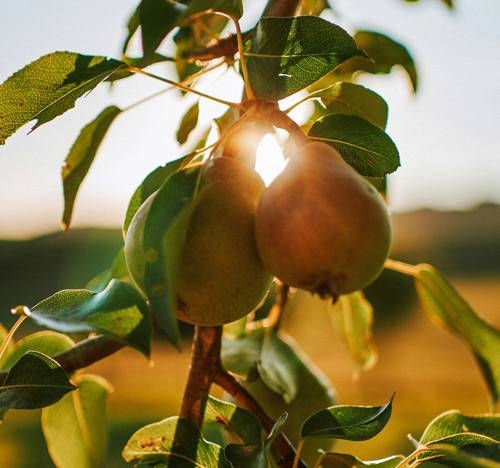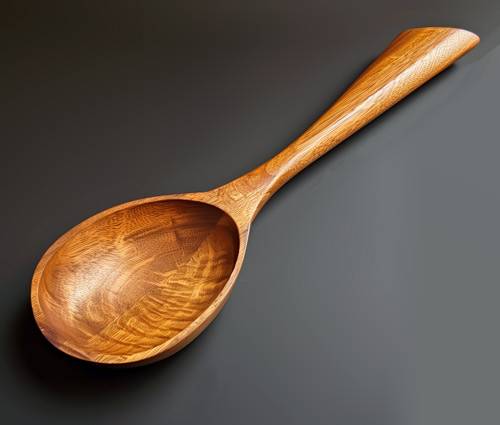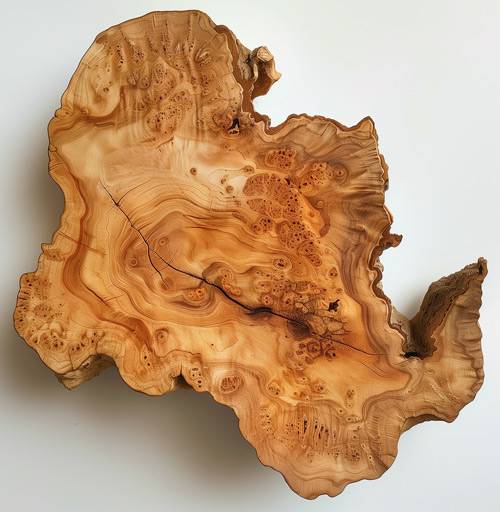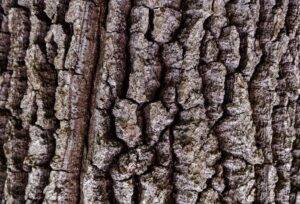Pear tree
Pear wood is highly sought after due to its rarity and unique properties, but it is also expensive. It is used in a variety of ways, especially for high-quality musical instruments as well as toys, brushes and baking utensils.
The pear tree is characterised by its distinctive crown, which often mirrors the shape of its fruit. Even in Ancient Greece, pear trees were grafted into different varieties, and today there are over a thousand different varieties of table and cider pears. Traditionally, an apple tree is typically planted for boys and a pear tree for girls.
The wood of the pear tree has a feminine, warm colour, which is intensified by steaming and can darken when exposed to sunlight. It is extremely fine-pored, hard, dense and tough, which makes it relatively resistant to water. It is mainly obtained from orchards and is therefore very valuable.
Thanks to its even structure, pear wood is easy to work with and is well suited for woodturning. It is regularly used for high-quality brush bodies, kitchen utensils, dough moulds and wooden bowls, as it remains smooth and does not wear out.

Overview of pear wood
- Pear wood has a long history and has been used since ancient times.
- Pear wood is highly sought after due to its unique properties.
- Pear wood is ideal for making furniture.
- Pear wood is also very popular as a material for kitchen utensils.
- Pear wood requires regular care to maintain its beauty.
The history of pear wood
Pear wood comes from the wood of the pear tree, a tree species that is mainly native to Europe. It is believed that the cultivation of pear trees began thousands of years ago, particularly in Ancient Greece and Rome. At that time, the wood was mainly used to make furniture.
Over the centuries, the use of pear wood has evolved. In the Middle Ages, it was often used to make musical instruments such as violins or flutes, as it produces a warm sound due to its special acoustic properties.
The unique properties of pear wood
Pear wood is characterised by its distinctive colour and grain. It has a warm yellowish to reddish colour with darker stripes and spots that give it a unique appearance. The grain can vary depending on the growing conditions of the tree and ranges from fine lines to striking swirls.
In addition, pear wood is known for its hardness and strength. It is harder than many other types of wood, such as pine or spruce, which makes it more resistant to scratches and wear. These properties make pear wood an excellent choice for furniture that is subject to heavy use.
Another advantage of pear wood is its resistance to moisture and pests. Due to its natural ingredients, it is less susceptible to rotting or insect infestation compared to other types of wood. This makes it ideal for use in kitchen utensils or outdoors.
Possible uses of pear wood in furniture production
Pear wood is often used in furniture manufacturing as it offers a variety of benefits. It can be used for various types of furniture, including tables, chairs, beds and cabinets.
An example of the use of pear wood in furniture making is antique chests of drawers or cabinets with ornate carvings. The characteristic grain of the wood gives these pieces a special charm and makes them real eye-catchers in any room.
In addition, the hardness and strength of pear wood makes it ideal for pieces of furniture that are subject to heavy use, such as dining tables or desks. It can also be used to build garden furniture as it is resistant to moisture and weathering.
Pear wood as a material for kitchen utensils
Pear wood is also an excellent material for kitchen utensils. Its resistance to moisture and pests makes it a hygienic choice for chopping boards, wooden spoons or salad bowls.
Another advantage of pear wood in the kitchen is its natural antibacterial effect. The wood contains natural ingredients such as tannins, which can inhibit the growth of bacteria. This makes it a safe choice for use in food processing.
In addition, pear wood has a smooth surface that is easy to clean and does not absorb residues. This makes it particularly suitable for contact with food and facilitates cleaning after use.

Care and maintenance of pear wood
Regular care is required to prolong the life of furniture or kitchen utensils made from pear wood. The wood should be regularly treated with a special wood varnish or oil to protect it from moisture and drying out.
It is also important to clean the wood regularly to remove dirt or food residue. This can be done with a mild detergent and a soft cloth. However, it is essential to avoid aggressive cleaning agents or abrasive cleaners, as these can damage the wood.
In addition, pear wood should be protected from direct sunlight, as this can lead to discolouration. It is advisable to place pear wood furniture in a location that is protected from direct sunlight.
Sustainability and environmental aspects of pear wood
The use of pear wood can be considered a sustainable choice. As the tree is native to Europe and is often cultivated, transportation distances are short and there are fewer CO₂ emissions compared to the use of exotic woods.
In addition, pear wood is typically sourced from sustainably managed forests. This means that for every tree felled, a new one is planted to preserve natural resources in the long term.
However, it is essential to ensure that the pear wood used comes from certified sources and does not support illegal logging methods.
Conclusion: Why pear wood is a special choice for wood lovers
To summarize, pear wood is a special choice for wood lovers. It is characterised by its unique colour and grain, is hard and resistant to moisture and pests. Pear wood can be used in many ways in furniture production and is also an excellent material for kitchen utensils.
The care of pear wood requires regular cleaning and treatment with special products to maintain its beauty. Using pear wood can also be considered a sustainable choice as it comes from local forests and is often sourced from sustainable forestry.
Overall, pear wood offers a variety of benefits for wood lovers looking for a unique and durable material. It gives pieces of furniture or kitchen utensils a special charm and ensures that they will give pleasure for many years to come.

Final words
In conclusion, pear wood is an exquisite choice for all wood lovers. Its unique properties make it a versatile material in furniture making as well as in the manufacture of kitchen utensils.
Regular maintenance can extend the lifespan of items made from pear wood. The sustainability and environmental aspects of pear wood make it a responsible choice for those who want to be environmentally conscious.
Overall, pear wood is a special choice for wood lovers looking for a unique and durable material. It adds a touch of elegance and naturalness to any room.
FAQs
What is pear wood?
Pear wood is the wood that is obtained from the pear tree. It is a hard and dense wood with a fine texture and a warm colour.
What are the properties of pear wood?
Pear wood is hard, dense and heavy. It has a fine texture and a warm colour that can range from light yellow to reddish-brown. It is also known for its durability and resistance to rotting.
What is pear wood used for?
Pear wood is used for a variety of applications including furniture, cutting boards, bowls, musical instruments and carvings.
How do I care for pear wood?
Pear wood should be cleaned and oiled regularly to maintain its beauty and durability. Avoid exposing the wood to excessive moisture or heat to prevent warping.
How do I recognize the quality of pear wood?
The quality of pear wood can be judged by its colour, texture and grain. High-quality pear wood has a uniform colour and texture, as well as an attractive grain. It should also be free of cracks, knots and other defects.





